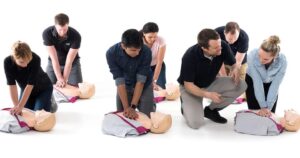
Summer’s warmth, increased humidity, and intense sun exposure can all take a toll on equipment and machinery. As we transition into the cooler months of the year, it’s crucial for businesses to assess and ensure that their tools and machinery are in peak condition. Routine inspections not only maintain the longevity of your equipment but also protect your workers from potential hazards.
Below, we present a comprehensive checklist for post-summer equipment checks. This can act as a guideline to ensure your equipment remains in optimal working condition, safeguarding your investments and most importantly, your team.
Post-Summer Equipment Safety Checklist
Visual Inspection: Before diving into detailed checks, begin with a general visual inspection. Look for any visible damage, wear, rust, or loose components.
Lubrication Checks: Summer’s heat can dry out or degrade lubricants. Check all moving parts for adequate lubrication. Replace any lubricants that appear dirty or have separated.
Cooling Systems: Machines that have cooling systems may have worked overtime in the summer. Check for any clogs, coolant levels, and ensure fans or other cooling mechanisms are working efficiently.
Battery Assessment: Hot weather can affect battery life. Ensure that batteries in equipment or tools are holding charge properly. Consider replacements for any that are underperforming.
Seals and Gaskets: High temperatures can cause seals and gaskets to dry out or crack. Examine all seals to ensure they remain intact to prevent leaks or equipment malfunctions.
Calibration: Ensure that any equipment requiring calibration is still accurate. Prolonged use in summer conditions may affect performance metrics.
Electrical Components: Humidity can impact the electrical parts of machinery. Check for any signs of corrosion or damage. Test all switches, buttons, and connections.
Filters: Dust and airborne particles may be more prevalent in summer. Replace or clean all filters on machinery and equipment.
Safety Features: Make sure that all safety guards, emergency stops, and other safety features are functioning properly.
Belts and Chains: Look for signs of wear, stretching, or damage. Replace any components that show significant wear.
Noise and Vibration: Turn on each machine and listen. Unusual noises or vibrations can be early indicators of wear or misalignment.
Documentation: Make note of any services, replacements, or repairs. Keeping an accurate log helps in preventive maintenance and ensures a longer lifespan for equipment.
- Check Manuals: Manufacturer guidelines can offer specific checks and maintenance schedules. Make sure you’re up-to-date.
Employee Feedback: Sometimes, the best insights come from those who use the equipment daily. Engage with your team and ask for their observations or concerns.
Final Thoughts
Post-summer maintenance isn’t just about increasing the lifespan of your equipment—it’s about ensuring a safe and efficient working environment. Remember, well-maintained equipment not only reduces the risk of breakdowns and costly repairs but also ensures the safety of everyone involved.
Reliance Safety Consultants is committed to providing you with the best advice and resources to ensure a safe workplace. Should you need further guidance or assistance with your equipment safety protocols.



